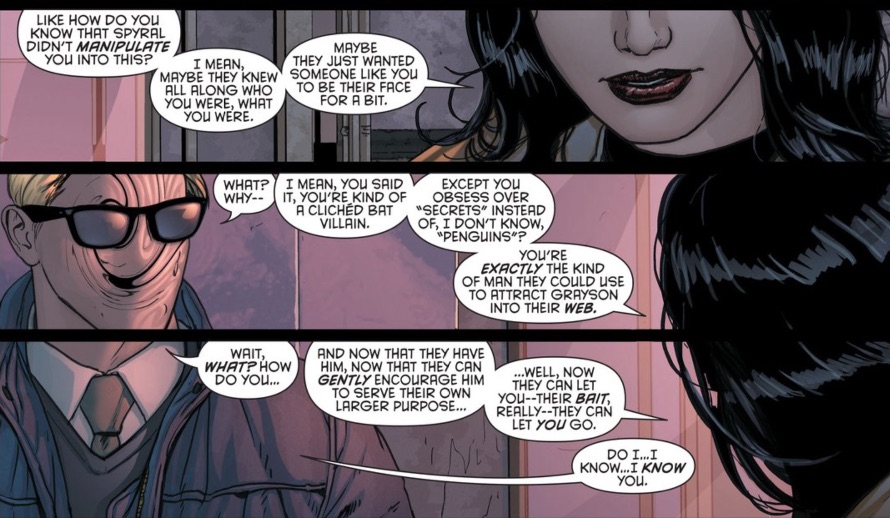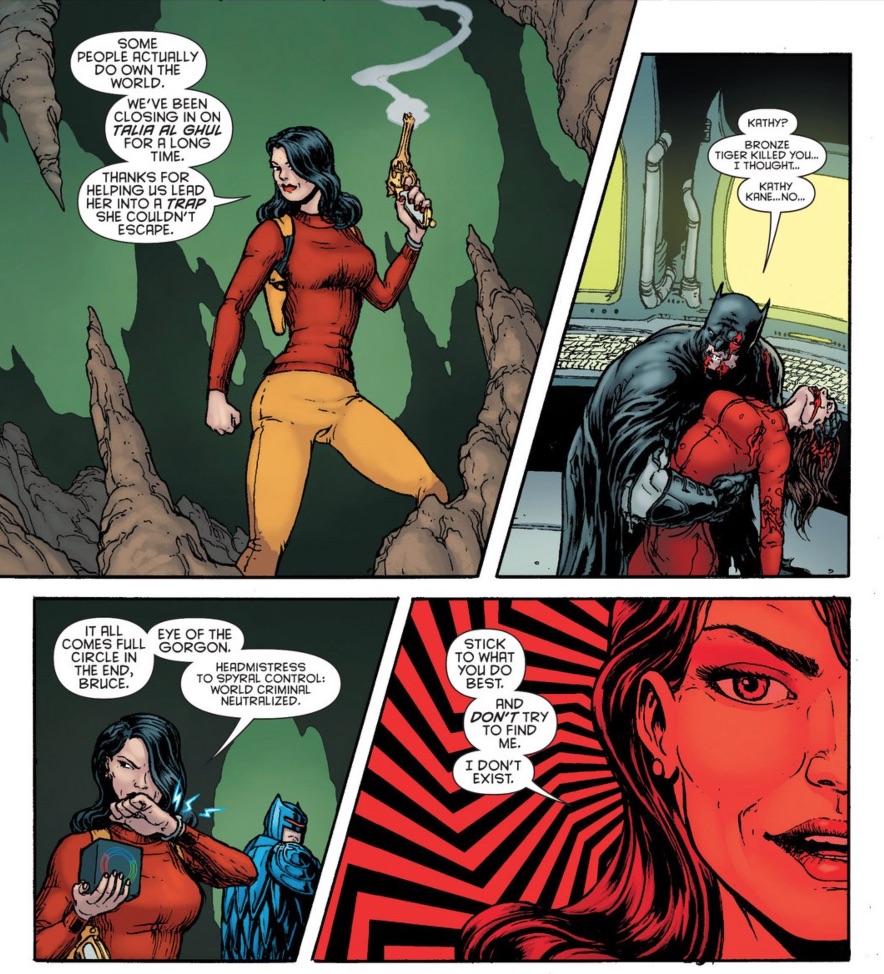Tim Seeley, Tom King, Mikel Janin and Stephen Mooney’s Grayson has been the rarest of ducks when it comes to follow-ups to Grant Morrison interpretations of characters: one that not only gets what Morrison was going for and accepts it, but builds on it without rehashing it. More than any other title DC’s put out since the conclusion of Batman Incorporated, it’s built on the themes Morrison embraced at the end of his run, both the general ones, such as accepting incompleteness and the dangling threads in life’s plotlines, as well as the more Bat-specific one, of acknowledging and lamenting Batman’s limitations, both as a character and as a story engine. While the book’s title character and protagonist, Dick Grayson, played a crucial role in Morrison’s story, it was nevertheless as an extension of Bruce Wayne himself: He kept the lights on while Bruce was gone, and backed him up while he was around. He did things his own way, but he was still maintaining his mentor’s house.
Meanwhile, in the last two years of his Batman run, Morrison had introduced the international espionage agency Spyral and its top agent Katherine Webb—also known to longtime readers as Kathy Kane, the Golden Age Batwoman who carried crimefighting gear in a Bat-Purse and liked to make kissy-kissy with Bruce’s aerorodential alter ego. This was much to young Dick Grayson’s considerable dismay, who feared losing the 25-year-old man who lived as his emotional equal and partner to the dangers of maturity and adulthood. Less James Bond and more The Prisoner, Spyral had a strict policy of organized, state-sanctioned hardcore mindfucking that drove Batman nearly to shit, until he realized it was just a (somewhat problematic, in retrospect) convoluted revenge plan by his baby mama Talia for winning the heart and soul of their son with the controversial masterstrokes of “love” and “affection.” They basically tug-of-warred on the poor kid until he got ripped in half, and Dick Grayson got really sad about it, and then Kathy Kane came in at the end to aerate Talia’s noggin and everyone lived sadly ever after. (Except for all the people who came back to life because it’s not a Grant Morrison superhero tragedy unless the fans get to eat their cake and have it too a year later.)
I honestly never expected to see Spyral, or the Hood, or Kathy Kane, or any of this stuff ever again, so I was more than a tad bit skeptical when they announced that, after his frankly random as all hell public unmasking as Nightwing in the pages of Geoff Johns and David Finch’s Forever Evil, he was going to join Spyral and become a superspy because… Spyral was trying to unmask the world’s superheroes, for some reason? While Grayson ended up being an excellent book, driven by the dual engines of Seeley’s out-there psychedelia and King’s thematic tautness and willingness to formally experiment (not to sideline Janin and Mooney’s perfectly pleasing superhero art storytelling), the use of Spyral never felt right to me, especially considering the reason Grayson infiltrated Morrison’s Spyral was above the petty concerns of the superhuman community; why would they give a shit about who Superman or the Flash is?
So it’s with great excitement that I say that after reading Grayson #8, it turns out that was a question I was supposed to have been asking all along. In what I can only describe as a truly impressive and transformative twist for the book, the series’ raison d’etre for the first year was, it turns out, complete and total bullshit. In a classic spy double-cross, it turns out the entire thing was a set-up by Kathy Kane herself because she thinks Dick Grayson —once the kid scared shitless of losing his adopted brother to her mature feminine wiles—is just too good and talented to be stuck dealing with and idolizing Batman’s eternal state of emotional arrested development. “Don’t try to find me,” she tells Bruce at the end of Incorporated; “stick to what you do best.” Grayson, though, she knows, is more than that. He can serve the “larger purpose” that she, and Spyral, work towards. Grayson, unlike Bruce, can grow up.
It’s an incredibly clever turn for the story that not only ramps the book’s connection with its narrative predecessors up to the next level, but it also exacerbates and complicates the book’s own emotional conflicts. As a child, Dick Grayson was afraid that Kathy Kane would take his brother and playmate away from him. It turns out, he had nothing to be afraid of, as Bruce simply couldn’t cut it in the high-stakes adult world of hypnotic implants and murder lipstick. Now, as an adult, while Kathy knew she’d never push Bruce past the moral code of that ten-year-old boy who watched his parents die in the street, she’s attempting to recruit Dick to her purpose, and rather than turning herself into a Bat to get his attention, is instead manipulating Dick to be more like her.

I’m incredibly excited to see Grayson continue past the two-month Convergence break and start really taking advantage of this emotional conflict, since it’s only just scratched the surface of a very rich vein of drama, one that tells a story completely new to the Batman mythos that simultaneously deeply honors its past. I can understand the impulse to sleep on this book as another Batman spinoff with a quirky premise, but it’s so much more than that. It’s one of the best books DC is putting out—hell, one of the best books it’s put out in years. If the psychedelic spy-fi mindfucking of Incorporated was up your alley and you either dropped out of the book or never checked in for some of the reasons I described above, I’ve got to highly recommend giving it another go with the aforementioned stuff in mind.
After a hiatus during DC’s Convergence event, Grayson returns with issue #9 in June.



